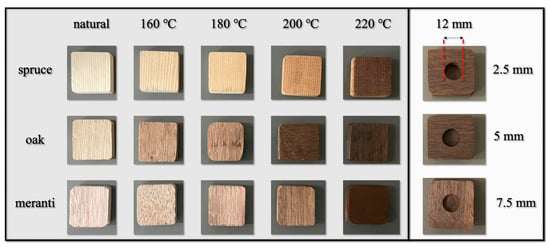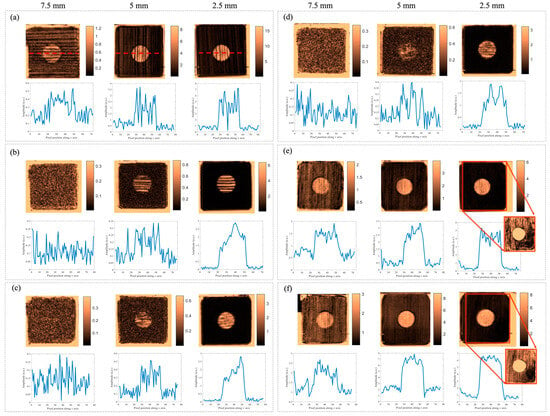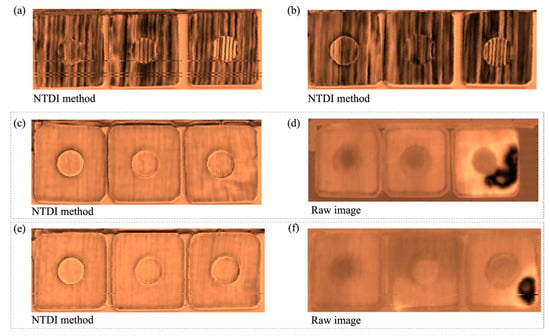Abstract
As commonly used materials in building and interior furniture decoration, wood materials should be processed via the pyrolysis technique in order to improve their corrosion resistance, flame retardancy, and dimensional stability. However, during the process of pyrolysis, temperature and time are significant factors for avoiding internal damage. The main reason comes from the decrease in internal structural water. Existing non-destructive evaluation methods have difficulty detecting moisture content and delamination within wood due to its complex internal structure. In this work, a novel image processing method is proposed to detect the delamination of wood materials. The results show that, compared to spruce and oak, meranti is more resistant to pyrolysis and has a higher structural stability.
1. Introduction
Wood is a naturally occurring organic material extensively utilized in construction due to its inherent attributes, such as remarkable strength and exceptional thermal and electrical insulation properties. However, wood possesses certain undesirable intrinsic characteristics, including swelling, shrinking, warping, and cracking. To address these challenges in wood processing and utilization, the concept of thermally modified wood has emerged. This entails subjecting the wood to a meticulously controlled pyrolysis process, involving the application of heat (>180 °C) in the absence of oxygen. The inspection of pyrolysis becomes a difficult new issue.
The density of wood plays a pivotal role in determining its modulus of elasticity and stiffness, as higher-density wood generally exhibits elevated values for these mechanical properties [1]. In the context of the pyrolysis process, the moisture content assumes a crucial role as a key parameter. Particularly when the moisture content hovers around 30%, careful and gradual drying becomes imperative to avoid potential issues such as cracking, warping, and other wood defects. Hence, it becomes essential to accurately detect and monitor the water content and potential damage of wood at various temperatures. To solve this problem, terahertz time-domain spectroscopy (THz-TDS) is introduced in this work for the examination of wood materials [2,3].
This paper presents a novel approach for detecting internal delamination. The amplitude at a specific frequency is utilized to effectively characterize the water content within the wood samples. A comparative analysis reveals that the meranti wood exhibits a greater resistance to pyrolysis and a higher structural stability when compared to spruce and oak.
2. Materials and Methods
2.1. Materials
As shown in Figure 1, the specimens investigated in this study comprised spruce, oak, and meranti wood. All samples possessed dimensions of 40 × 40 × 10 mm. The three groups of wood specimens can be divided into untreated wood and thermally modified wood at temperatures of 160 °C, 180 °C, 200 °C, and 220 °C. Prior to the pyrolysis process, each sample was intentionally provided with manually created flat-hole defects. The depths from these flat-bottom holes to the sample surface were set at 2.5 mm, 5 mm, and 7.5 mm, respectively, while their diameter remained consistent at 12 mm.

Figure 1.
Specimens processed by pyrolysis.
2.2. Normalized Time-Domain Integration Method
In the THz-TDS system, when an incident wave passes through a specimen, the received THz signals encompass multiple echoes. These echoes manifest in an integrated form rather than discrete form, resulting in variations in the shape of THz waves. Consequently, distinguishing between the defect and non-defect areas becomes relatively straightforward when observing the wave shapes in simpler structural specimens. However, when dealing with specimens characterized by complex internal structures like porous materials, analyzing the signal discrepancies between the defect and non-defect areas becomes challenging. To address this issue, the authors introduced a novel image processing technique known as the normalized time-domain integration (NTDI) method.
As we all know, a THz wave is generated by femtosecond laser pulse and photoconductive antenna, which is linearly polarized and has a broadband nature in the frequency domain. Therefore, it is possible to find that the THz wave in the time-domain is not a standard Gaussian pulse. In general, it is always a negative value in time-domain integration. This means that if there are more THz echoes generated by defects, the value of the time-domain integration is smaller. Based on this phenomenon, the internal structure of specimens can be detected precisely.
3. Results and Discussion
3.1. Water Distribution Evaluation
The water distribution of meranti samples at different pyrolysis temperature is shown in Figure 2. For different signals, the lighter the color, the higher the amplitude value, and the lower the water content. It is obvious that the color of wood becomes lighter and lighter, which means the water content becomes lower and lower with the increase in the pyrolysis temperature. In addition, there is an area with low water content on the lower right side, which will be discussed in the next section.

Figure 2.
Water content characterization by amplitude image of THz-TDS: (a–c) are natural spruce, oak, and meranti specimens; (d–f) are meranti specimens at 180, 200, and 220 °C.
3.2. Delamination Detecion
Figure 3 shows the delamination detection results for the three types of wood. It is obvious that the meranti has the best resistance to pyrolysis. This is due to the fact that there is no dark area in the NTDI images for the meranti specimens. In particular, for the raw image in Figure 3d,f, there are obvious areas of color differences. They can be considered defective areas through experience. However, this was proven wrong by observing the NTDI images. In fact, the abnormal area is caused by the water content instead of delamination, which is discussed in the previous section.

Figure 3.
Delamination detection based on NTDI method: (a,b) are spruce and oak specimens at 220 °C; (c,d) are meranti specimens at 200 °C; (e,f) are meranti specimens at 220 °C. The dotted box denotes the difference between the raw image and NTDI image for the same specimen.
4. Conclusions
In this study, the authors successfully achieved two objectives involving terahertz time-domain spectroscopy (THz-TDS) and wood materials. The first objective involved the characterization of the water content and its distribution using amplitude images. The second objective focused on detecting the delamination in materials possessing intricate internal structures. To address this challenge, the authors introduced a novel algorithm called the normalized time-domain integration (NTDI) method. All wood samples were evaluated using this method, which demonstrated remarkable accuracy and robustness in detecting delamination. Notably, an anomalous area detected in the meranti sample at a pyrolysis temperature of 200 and 220 °C was determined to not be associated with delamination, but was rather linked to the water content. The study further verified the efficacy and precision of the NTDI method in this context.
Author Contributions
Data curation, P.Z.; investigation, P.Z., H.Z., E.P. and S.S.; writing—original draft preparation, P.Z.; writing—review and editing, H.Z., E.P. and S.S.; resources, E.P. and S.S.; supervision, H.Z. and X.M. All authors have read and agreed to the published version of the manuscript.
Funding
This research was funded by the Natural Sciences and Engineering Research Council (NSERC) Canada through the Discovery and CREATE ‘oN DuTy!’ program, as well as the Canada Research Chair in Multipolar Infrared Vision (MiViM). This research was also supported by the National Key Laboratory of Science and Technology on Advanced Composites in Special Environments through Open-end Research Fund program (no. 6142905213301).
Institutional Review Board Statement
Not applicable.
Informed Consent Statement
Not applicable.
Data Availability Statement
Data are contained within the article.
Conflicts of Interest
The authors declare no conflict of interest.
References
- Todoruk, T.M.; Hartley, I.D.; Reid, M.E. Moisture Content and Fiber Direction of Wood. IEEE T THz Sci. Technol. 2012, 2, 123–130. [Google Scholar] [CrossRef]
- Hu, J.; Zhang, H.; Sfarra, S.; Pivarčiová, E.; Yao, Y.; Duan, Y.; Castanedo, C.I.; Tian, G.; Maldague, X. Autonomous Dynamic Line-Scan Continuous-Wave Terahertz Non-Destructive Inspection System Combined with Unsupervised Exposure Fusion. NDT & E Int. 2022, 132, 102705. [Google Scholar]
- Hu, J.; Zhang, H.; Sfarra, S.; Santulli, C.; Tian, G.; Maldague, X. Novel Infrared-Terahertz Fusion 3D Non-Invasive Imaging of Plant Fibre-Reinforced Polymer Composites. Compos. Sci. Technol. 2022, 226, 109526. [Google Scholar] [CrossRef]
Disclaimer/Publisher’s Note: The statements, opinions and data contained in all publications are solely those of the individual author(s) and contributor(s) and not of MDPI and/or the editor(s). MDPI and/or the editor(s) disclaim responsibility for any injury to people or property resulting from any ideas, methods, instructions or products referred to in the content. |
© 2023 by the authors. Licensee MDPI, Basel, Switzerland. This article is an open access article distributed under the terms and conditions of the Creative Commons Attribution (CC BY) license (https://creativecommons.org/licenses/by/4.0/).